
Plantar fasciitis is much more common than you think
One-in-10 Americans will experience the pain of plantar fasciitis (PF) during their lifetime. Also called plantar fasciopathy, it’s the most common cause of heel pain in adults and is responsible for over 1 million doctor’s visits every year. A diagnosis of plantar fasciitis is more common among women between 40 and 60.
And while plantar fasciitis can affect sedentary people, it’s most prevalent among runners, affecting between 5-10% of runners. Plantar fasciitis is typically diagnosed based on physical exam and patient symptoms, although sometimes your foot ankle specialist might order radiology studies to help with diagnosis.
What are typical plantar fasciitis symptoms?
Plantar fasciitis usually presents as a stabbing pain, felt first thing in the morning, originating along the inner (medial) side of the heel bone (calcaneus) and extending along the inner arch of the midfoot to the anterior foot. Pain and tenderness in the calcaneal area progress with loading and activities as the day goes on. And, as any sufferer will tell you, the musculoskeletal pain associated with plantar fasciitis greatly affects quality of life.
How is plantar fasciitis traditionally treated?
Treatment of plantar fasciitis begins with conservative modalities like stretching exercises, ice massage, and non-steroidal anti-inflammatory drugs. Sometimes your healthcare provider might prescribe night splints (to stretch your calf and foot arch while you sleep) and rigid orthoses (shoe inserts to distribute your weight more evenly on your foot).
In recent years, cases that have failed to respond to conservative management have been treated with interventional modalities such as corticosteroid injections, extracorporeal shock wave therapy, amniotic membrane, or PRP (platelet-rich plasma) injections into the fascial tissue, all of which have shown varying degrees of success. But there was always a small percentage of patients who could not get plantar heel pain relief with any of these treatment options. Until one day…
University Foot and Ankle Institute doctors proved that intense therapeutic ultrasound may be the “silver bullet” for treating chronic plantar fasciitis pain
Drs. Gary Briskin and Bob Baravarian participated in a 2018 FDA clinical trial that gauged the effectiveness, safety, and tolerability of Intense Therapeutic Ultrasound Therapy for plantar fasciitis.
The study included patients who had failed conservative treatment and was conducted at University Foot and Ankle Institute in Santa Monica, CA.
Much to everyone’s surprise, they found that this non-invasive treatment modality not only significantly reduced plantar fasciitis pain but was also well tolerated by patients.
The study participants reported high satisfaction and function scores for up to six months after undergoing just two ultrasound treatments, four weeks apart.
What’s more, Briskin and Baravarian’s colleagues were able to prove via sonographic imaging that Intense Therapeutic Ultrasound Therapy actually helped to break up scar tissue, create new blood vessels, and potentially spur some regeneration of damaged nerves.
UFAI’s research on Intense Therapeutic Ultrasound for plantar fasciitis
While you can find full details of the study findings in the Journal of Foot and Ankle Surgery, here’s a recap in plain English.
- The doctors were interested in studying the effectiveness of Intense Therapeutic Ultrasound (or ITU) administered to patients who were already undergoing conservative plantar fasciitis treatment with inadequate pain relief. The goal of the study was to reduce overall pain by 25%.
- Thirty-three patients aged 31 to 73, with chronic plantar fasciitis symptoms lasting on average 19 months, enrolled in a single-blind study in which they each received two ITU treatments four weeks apart while they continued their routine treatment regimen (like five minutes of daily massage, icing, physical therapy, and orthotic inserts).
- Each ITU treatment involved exposing the plantar surface of the foot with 5 joules of ultrasound frequency for 15 to 20 minutes per foot. A total of two treatments were performed, four weeks apart. Following their initial session, all participants wore orthopaedic immobilization boots for up to one month.
- Study participants were then followed for up to 6 months, coming in for a physical exam, patient surveys on pain and function, and diagnostic ultrasonographic studies at weeks 4, 8, and 12, and then participating in a phone survey at week 26 after their last treatment.
What were the findings of the plantar fasciitis study?

The results showed that Intense Therapeutic Ultrasound Therapy achieved statistically significant pain relief and functional improvements in chronic plantar fasciitis sufferers. The details were:
OVERALL PLANTAR FASCIITIS PAIN IMPROVEMENT
At each follow-up visit, patients were asked if their pain had decreased by at least 25%.
- 72% of patients reported pain reduction greater than 25% after one month.
- After three months, this figure increased to 86% of participants.
PLANTAR FASCIITIS PAIN IMPROVEMENT AFTER EACH TREATMENT
Participants were asked how bad their pain was two to three days after the second treatment. On a scale of one to ten (10 being worst), participants reported significant differences in their pain level:
- 68% reported zero pain
- 26% reported pain intensity from 1 to 3
- 3% ranked their pain from 4 to 7
- 3% described their pain between 8 and 10
PAIN DURING TREATMENT
Since no anesthetic was used during the intense ultrasound session, patients were asked how much the treatment hurt. On a pain scale of one to four (four being the worst) they reported:
- During the first treatment, the average was 3.4
- During the second, average pain fell to 2.9.
DAILY FUNCTION IMPROVEMENTS
Participants were asked to score how their plantar symptoms limited their ability to perform daily activities, ranking their functionality on a 90 point scale (90 being best).
- 2 to 3 days after their initial treatment, the average function score was 60
- 8 weeks after their final treatment, function scores rose to an impressive 83.3!
PLANTAR FASCIITIS TREATMENT SATISFACTION
At each follow-up, participants were asked to rank how satisfied they were with their improvement.
- At the start of the clinical trial, 72% of participants reported they were satisfied with their outcomes
- By 12 weeks, participants satisfaction grew to 90%
PLANTAR FACIA THICKNESS AND DAMAGE
Diagnostic ultrasonography was performed at each visit to measure plantar fascia thickness and soft tissue damage (the lesion).
- At week 4 (after the final ITU session), the average lesion size decreased by 27% from baseline.
- At week 12, the average lesion had shrunk by over 67%!
University Foot and Ankle Institute are leaders in developing new treatments that advance foot and ankle care
Our patients rely on our decades of experience in developing, researching, and using the latest technologies to help bring pain-free activity back to their life. If you want to learn more about the treatment of chronic plantar fasciitis to return to competitive sports or simply to play with your kids, you can trust our physicians to know which advanced therapies might best suit your specific condition.
If you’re suffering from foot pain and have not received adequate relief or care, or if you’re merely interested in obtaining a second opinion, please click here or call 877-989-9110 to schedule a consultation.
At University Foot and Ankle Institute, we take our patients’ safety seriously. Our facility’s Covid-19 patient safety procedures exceed all CDC recommendations.
University Foot and Ankle Institute is conveniently located throughout Southern California and the Los Angeles area as our foot doctors are available at locations in or near Santa Monica, Beverly Hills, West Los Angeles, Manhattan Beach, Northridge, Downtown Los Angeles, Westlake Village, Granada Hills, and Valencia, California.
- Avoiding Foot and Ankle Overuse Injuries While Dog Walking - July 17, 2023
- What is Floating Toe Syndrome? - June 12, 2023
- Is there a link between gout and heart disease? Studies Say Yes - February 22, 2022
